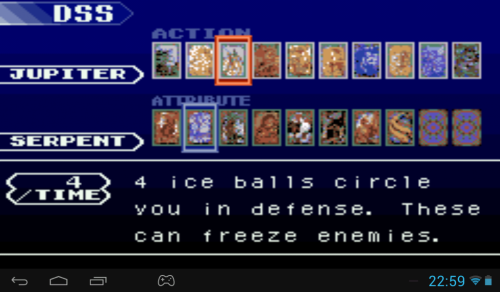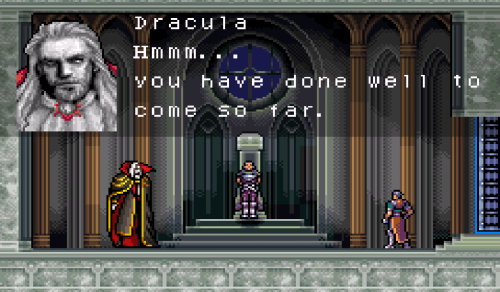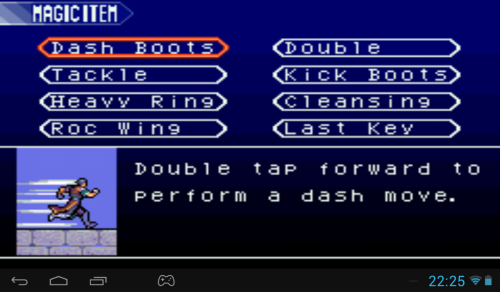After about eleven of twelve hours of game play in total, and exactly 10 hours and 35 minutes being shown on my save file, Castlevania: Circle of the Moon is now completed. There are extra modes to play through, but I probably wont invest a lot of time into that. Now that the game is over, I’ll try and give a second overview – one that will hopefully be more accurate.
What is Metroidvania anyway?
It’s difficult to think of a precise definition. Simply put, there are elements a game ought to have if we are to call it a metroidvania games. Which elements these are varies from definition to definition, but there is some common ground to be found. These the elements I consider to be part of a metroidvania game:
- The game is one, huge world. The player gains access to parts of the world by overcoming challenges such as bosses, which then teaches him abilities or gives him equipment that allows him to circumvent barriers within the game world.
And that’s it. Everything else is flavor. However, there are things I consider good flavor and things I consider not quite as good. For instance, there’s the whole difficulty thing.
I like when a metroidvania game is challenging, but fair. If you do your homework and play it right, with some forethought, you can win. If you’re skilled, you can even win with the bare minimum requirements. On the subject of Circle of the Moon, there are YouTube videos where people are defeating bosses without using any sub-weapons or spells taking zero damage throughout the fight. This take skill, but it’s clearly possible.
However, not everyone is that skilled. Most people will use everything they have available and they’ll still lose often. At that point, it’s a matter of doing one of the following:
- Master the controls and learn the boss’ patterns, eventually mastering and winning the fight.
- Use the RPG elements (which is something I like having in a metroidvania game) to your advantage and make your character stronger, which creates a larger margin for errors in any boss battle.
- An even mix of both – both the player and the character get a bit better, and suddenly the boss is beaten and the area is conquered.
And there I go letting this post wander.
The question was, what is a metroidvania game? The answer is that I’m not really sure. Take a look at Symphony of the Night, Circle of the Moon, Aria of Sorrow or any of the myriad other games that are often described as metroidvania and decide for yourself.
One thing is for sure, it’s a unique sub-genre that I very much enjoy.
Game report
I’ll keep this part short.
I’ve been steadily progressing through the game in relatively short sessions and it took me about two weeks of sporadic play to get through Circle of the Moon.
Once I’ve finally beaten Dracula, there was a second form in some sort of other dimension type place, that I had to beat. Compared to everything up to that point, it was insanely hard. It was actually able to kill me in 2 or 3 moves.
While it was certainly possible to beat it at that point, and there are videos that prove it, I decided to take a step back here and do some of the optional stuff.
I’ve collected all but two of the cards, due to the last two being in a difficult optional area. I also got what I consider to be the strongest equipment I could find outside of this last area – two Dual Grips dropped by Dark Armor enemies, as well as a Dark Armor (the item), dropped by Lilim, a special enemy in a hidden area.
With that, I gave the Battle Arena (the optional area I mentioned above) one last shot, failed and then went back to Dracula. It was surprisingly easy and I managed it on my first try. I wasn’t even taking much less damage than before. I just managed to execute a few well placed moves at the correct time and that was all it took to beat Dracula and the game.
Finishing the game gives you a password – FIREBALL. Entering this as the name for a new save file enables the Magician play mode. This is the exact same game as in the regular mode, except Nathan’s starting stats are balanced for you to play almost exclusively with spell cards. I gave that a try to and died to the Earth Demon. It’s difficult.
As I was writing this, though, I realized you also start with all the cards unlocked, so there’s that…
I did some research and there are actually multiple modes you get to unlock one after the other, but that’s something I’ll talk about in a few paragraphs.
Castlevania: Circle of the Moon – Features
Exploration abilities
Exploration abilities are the core of a metroidvania game. These allow you to get past certain barriers and enter new areas of the game world. While all the other stuff is flavor, in my book, withouth exploration abilities and gating based around these, it’s not a metroidvania game.
In Circle of the Moon, abilities are gained from special items you find, usually in rooms guarded by bosses. Once you have an item, that ability is active and usable at all times. There is no need to equip the item or anything of the sort.
Castlevania: Circle of the Moon – List of Exploration Abilities
| Order | Name | Description |
|---|---|---|
| 1 | Dash Boots | Allows Nathan to double tap a key to run in that direction. This means you get to jump a bit further to. |
| 2 | Double Jump | Allows Nathan to double jump, further increasing jump range and height, together with the dash move. |
| 3 | Tackle | Hitting a key while moving forward causes Nathan to charge. This does damage and can destroy certain stone blocks. Outside of circumventing the stone blocks, it’s not extremely useful. |
| 4 | Kick Boots | Allows Nathan to kick off walls, enabling him to get through certain narrow vertical shoots and reach higher-up areas. Not very useful outside of exploration. |
| 5 | Heavy Ring | Allows Nathan to push heavy wooden blocks that block some passages. There is no use for this ability outside of this. |
| 6 | Cleansing | Cleanses polluted waters in an underground area, allowing exploration of it. No other use outside of this. |
| 7 | Roc Wing | Allows Nathan to jump to great heights vertically, reaching new areas. You can use it multiple times in the air and it really speeds up navigation of old areas as well as unlocking new ones. |
| 8 | Last Key | Unlocks the room past the entryway where Nathan got separated from his master. No other use for this item. |
Overall, the exploration abilities could have been better.
They serve their purpose, but I consider it a bit of a waste to three out of 8 items give Nathan abilities completely useless outside of the primary function of getting past a barrier. The Heavy Ring, Cleansing and Last Key have absolutely no other use in the game except to unlock a new area.
Tackle is slightly useful at times, but not very much and it can easily be replaced by the default slide dash move Nathan starts with.
My memory isn’t the best, so I’m not sure how later games handle it, but in my opinion, exploration abilities are far cooler when they can be used outside of their primary function.
Leveling system
The leveling system is basic, but it works and gives you consistent and noticeable improvements throughout the game. Each new level provides an overall stat boost, meaning you take less damage and deal more, and get a boost in available resources (magic, health and hearts).
As I mentioned in my first posting, there are also permanent stat boost items scattered throughout Dracula’s castle – a staple of most newer Castlevania games.
Equipment system
There aren’t a lot of items, but they vary in stat growth greatly, so each new item is an interesting find. There are straight upgrades, but there are also equipment pieces that allow the player to customize their character.
You can have a setup with high luck, for item or card hunting, you can focus on strength, defense or magic and all of it can work, if you play well enough.
There’s also common and rare equipment, as well as some unique stuff you get as a reward for clearing difficult areas or beating difficult enemies.
Special system
Every newer Castlevania game I can think of also has something special – some special mechanic or system you get to play with and master.
In Circle of the Moon, this is the DSS – Dual Skill System.
There are cards in two groups – Action and Attribute. You pick one card from each group and this provides you a special effect. You might get an elemental whip attack, an extra projectile fired as you strike, a magical shield, a familiar, a spell or something as basic (and awesome) as increased movement speed.

Pictured: The DSS menu. The currently selected cards as well as their combined effect are displayed.
The first card group (Action) determines the type of effect, while the second (Attribute) determines the element. The game won’t immediately tell you what effect a certain combination will give you – you need to figure it out yourself. However, once the effect actually occurs, even if you somehow don’t notice it yourself, you will see a description of it in the menu.
Cards are dropped by monsters and there’s no guaranteed drops. In my first game, I thought the first few cards are guaranteed, but I gave the magician mode a try and I’m now certain it’s all random.
If you’re a completionist, this might annoy you. If you intend to play the game multiple times and don’t usually worry about getting it all in one go, this will actually provide for a lot of variety. Having access to different sets of cards on each playthrough can completely change your playing style.
World, enemies, bosses
Some familiar bosses are here. Some familiar enemies are also here. Some familiar bosses are now regular enemies and some regular enemies are now bosses (probably).
Outside of that, I wouldn’t want to spoil too much. Part of the charm of every Castlevania sequel is seeing for yourself how they designed that one staple enemy this time.
The story doesn’t involve the Belmonts and that’s about as much as I’m going to say. As far as stories go, it’s basic and not very surprising, not that this ever mattered in a Castlevania game. All I need is the basic plot and setting.
Extra game modes and content
This is another staple of Castlevania games.
First, there’s a whole optional area within the game – the Battle Arena.
Inside of the Battle Arena, there is no DSS and no magic. All you get to use are items, your weapons and your sub-weapons.
The goal is to get through a series of rooms with difficult enemies, all in one go. You get to give up after certain parts of the challenge, to at least keep your accumulated experience and item drops, but if you do, you have to do it all over from the beginning. If you get to the end, you get the strongest armor in the game – the Shinning Armor.
The thing is, that description is debatable. There’s the Dark Armor, which is a random drop from a hidden enemy, that provides more defense but also reduces all other stats slightly. The thing is, Defense is quite important, so both armors are quite close.
Of course, there are the bragging rights you also earn if you clear the Battle Arena.
But on to the extra game modes…
There are extra game modes. As of right now, I have one unlocked – the magician mode. After beating the game for the first time, i got a password – FIREBALL. Creating a new save file with this name starts Nathan off with a slightly different stat balance. He has less health and is overall weaker physically, but he’s far stronger in the magic department. He also starts with all the cards unlocked and available.
I did some research and found out there are multiple other modes you progressively unlock as you beat them one after another.
Last words
Overall, it’s very obvious that this is the first GBA Castlevania game. It’s the most basic and the most noticeably aged of the bunch. It’s still a damn good game, though.
As I said, I’m thinking about playing through the franchise and making a comparison. I’m also thinking about playing and making a comparison against other metroidvania games. since I’m honestly not that familiar with most of them.
I can’t make any promises, though. There are so many games to play and so little time.












